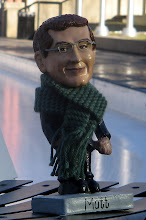After the concert, New World's VP of communications, Marc Fest, asked me to write something about Vladimir Feltsman for the next in a series of "Inside the orchestra" commentary pieces in the Nuevo Herald, Miami's main Spanish newspaper. So less than a day after I launched my blog and my first attempt at self-publishing, it looks like I'm about to be translated into Spanish!
I had an idea about what to write, which I will paste into the end of this posting. It's probably a bit too long to use uncut, though. I was a little challenged to come up with something interesting and positive - Vladimir Feltsman is a brilliant musician and a wonderful pianist, but his conducting left a little to be desired. Here's what I wrote:
Listening to a great musician like Vladimir Feltsman perform, I am struck by his command. He seems to have complete control, not only over his own hands and the keys and pedals of the piano, but over the sonorities as they emerge from the instrument and take shape in the space of the concert hall. Performing as a conductor, without any direct control over the production of sound, Mr. Feltsman's artistry at sculpting a sonority, guiding it all the way into the listener's consciousness, was often remarkable nonetheless. This skill was particularly notable in a concert with so many unusual and unexpected sonorities to organize.
I was principal bass for one of the pieces on the program, the US premiere of Sofia Gubaidulina's Stufen, and I was initially a little concerned because the score called for the bass section to divide into eight independent parts - we only have seven bass players. What Vladimir Feltsman explained, however, and what we quickly realized in playing the piece, was that the intent was not so much like a Bach invention with eight distinct voices, but like a chorus of insects chirping on a hot summer night. The effect was to sound like an infinite number of instruments might be playing, then gradually subsiding to only a few.
Several of the pieces on the program had sections of more or less aleatoric music, meaning that the notes and rhythms we played were not strictly dictated in the score. In situations like this, we look to the conductor for subtle clues for how to shape our collective improvisations. When done well, the effect can be mysterious and beautiful - as Michael Tilson Thomas, who conducted one of the pieces on the program explained, "Everyone goes ape a little differently," an idea I found strangely profound.
I'll post a link here if and when my piece gets published!


 Technorati Link Count: no. of blog reactions to this post
Technorati Link Count: no. of blog reactions to this post
No comments:
Post a Comment